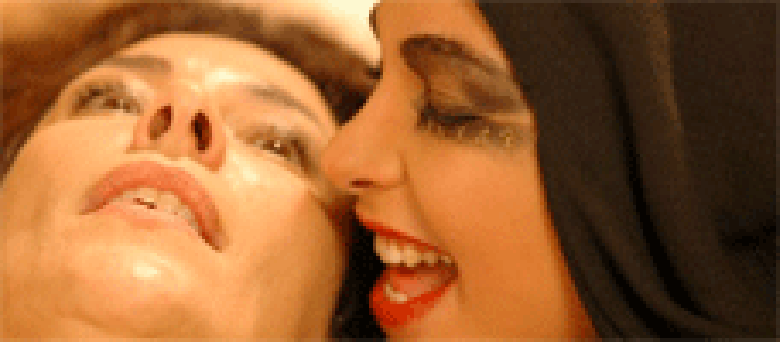Reviews
La Terza madre / The Third Mother
Dario Argento
Italy / USA, 2007
Credits
Review by Rumsey Taylor
Posted on 05 June 2008
Source 35mm print
Dario Argento’s Mother of Tears, a feeble, incidental continuation of his earlier films Suspiria and Inferno, is preceded by the thought that he hasn’t made a truly great film in over twenty years. And also that this, a pronounced attempt to establish lineage with two of his best films (1977 and 1980, respectively), is potentially a contrived cinematic creation no greater in repute than, conveniently, Speilberg and Lucas’ recent attempt to reprise their older, peerless successes.
More admirably, Mother of Tears is something of a resurrection of a subgenre - that is, supernatural European horror, for lack of a proper nomination - in which Argento enjoyed the pinnacle of his efforts as a filmmaker. But subgenres are beset by chronological ephemerality—a 2008 supernatural European horror film just isn’t the same thing, fundamentally, as a 1980 one. It’s an inherent, if indescribable impurity, even if the lineage this film boasts (in its subtitle, “The Third Mother”) pronounces otherwise.
To be fair, it does possess what amounts to Argento’s strengths as a filmmaker: hilarious and apparently dubbed dialogue, supernatural conflicts, histrionic bursts of aestheticized violence. As such, it’s a moderately entertaining film, a reprisal of key themes in Argento’s earlier work even if it fails to achieve the same chaotic heights. But there’s no harm in trying: it takes less than ten minutes for the film to genuinely seem an Argento one, and once it does the film is sustained by the same presence of some sinister, indistinguishable force. In other words, in less than ten minutes a woman is suddenly mutilated by demons, and asphyxiated with her own small intestine.
What’s key to appreciating Argento is understanding his use of violence, which to unaccustomed eyes surely has an effect of shock or disgust. Shock and disgust aren’t the intentions, however. Argento’s films are foremost potent, colorful palettes, and violence is typically in service to both these palettes and the atmosphere of dread. My favorite example is in Tenebre, in which a woman has her forearm chopped off cleanly by the giallo killer with a meat cleaver. She grasps the wound, and carefully aims the offshoot - which is shooting out like water from a spigoted hose - at a white wall, bathing it in fluorescent red blood before she collapses out of the frame. This instance - the painting - is what makes the film great.
Mother of Tears has neither the revelations of Tenebre nor the expressionistic lighting of Suspiria or Inferno, but its gothic atmosphere is more or less the same. The aforementioned death scene is preceded by the excavation and opening of an almost two-century-old urn, found in a church graveyard in Rome. It is covered in obscure hieroglyphs, and it contains similarly impending implements: statues, and a red gown with more weird glyphs on it. These glyphs initially mean nothing (even though the exhumers can feebly interpret them), but they’re to be recognized as icons of harm. The violence - the blood, the demons, the small intestine-cum-noose - verifies them as such.
Once these demons are unleashed they appear to be transmitted about Rome, imparting masochistic tendencies in whomever they encounter, be it human or not. A woman is suddenly compelled to toss her newborn off a bridge, a troupe of Goth girls terrorize an airport—this is all inspired by the Mother of Tears, and the film very generally concerns the attempt to best her. And as with Argento’s other supernatural films, the plot is something of an afterthought; unlike them, the film doesn’t indulge as expressionistically in the visual department. Their plots and violence excepted, both Suspiria and Inferno are highly expressionistic films, and each boasts wonderful color palettes that would characterize no other film—Suspiria in fluorescent, Art Deco pastels, and Inferno almost entirely in blue and red hues. These films look absolutely beautiful, and Mother of Tears fails to equal them in its visuals, which are more naturalistic, and this is its greatest fault. The earlier two films had plots that resist deciphering; they’re more mood pieces. Here, the mood is the same, but it enjoys no expressionistic flourish that was once Argento’s central aesthetic conceit.
Mother of Tears encourages criticism because it summons comparison to two films that are unequivocally better than it is—it’s to its fault that it’s part of a loosely contrived trilogy. This trilogy - deemed the “Three Mothers Trilogy” - has also a weak purport; each has an antagonist in one of three witches - sisters - in Freiburg, New York, and Rome, and each witch is initially pursued by a young woman, and that’s essentially it. This is merely the groundwork upon which a masterful visual aesthetic is put on display—except, that is, in this case. Still, this remains a Dario Argento film, failure or not, even if he is no longer exercising his talents with demonstrable abandon.
We don’t do comments anymore, but you may contact us here or find us on Twitter or Facebook.



